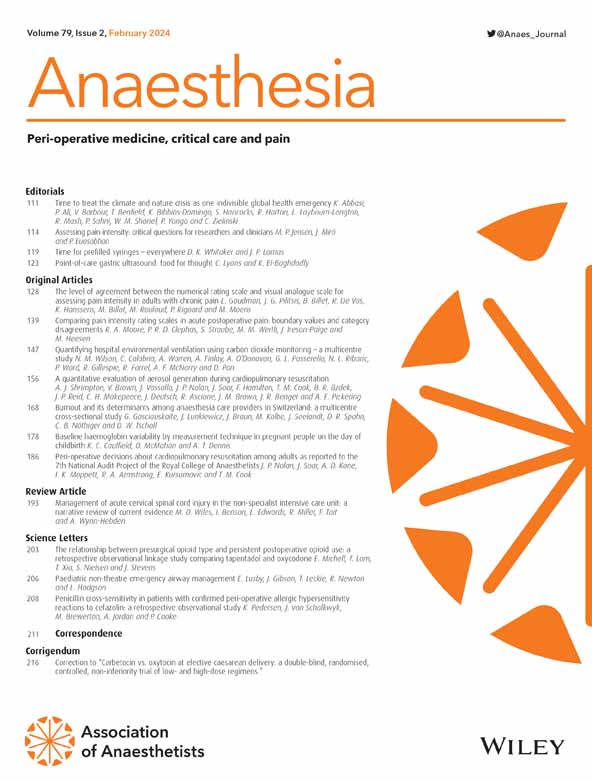全身麻醉期间基于体重指数的呼气末正压调整:一项随机对照试验。
IF 7.5
1区 医学
Q1 ANESTHESIOLOGY
引用次数: 0
摘要
肺保护性通气对预防术后肺部并发症至关重要。虽然保持较低的驱动压力和优化PEEP很重要,但理想的策略仍然存在争议。本研究评估与标准PEEP相比,基于BMI调整PEEP是否能降低驱动压和围手术期肺通气损失。方法我们进行了一项随机对照、患者盲法、单中心优势试验,分为两个平行组。接受全麻手术且需要气管插管的成年患者被随机分配到标准化PEEP (PEEP = 5 cmH2O;组PEEP-5)或根据BMI设置PEEP (PEEP = BMI/3 cmH2O;组PEEP-BMI / 3)。患者肺通气采用容量控制模式,潮气量为7 ml。Kg-1预测体重。术前和术后采用超声评估肺通气评分。结果纳入60例患者,随机分配。根据BMI/3调整PEEP与驾驶压力显著降低相关,PEEP-5组的中位数(IQR[范围])为8.9 (7.1-10.4 [5.2-14.9])cmH2O, PEEP-BMI/3组的中位数(IQR[范围])为7.9 (7.2-8.5 [5.9-14.1])cmH2O (p = 0.027),平均(SD)呼吸系统顺应性更高(PEEP-5组,0.83 (0.20)ml cmh20 -1 kg-1预测体重,而PEEP-BMI/3组,0.95 (0.17)ml cmh20 -1 kg-1预测体重;p = 0.020)。肺超声显示BMI/3组患者术后肺通气损失减少。分配到bmi调整组的患者需要较少的补充氧,新发生的肺不张较少,并且在到达麻醉后护理单元时具有较高的氧饱和度。在无重大肺部疾病的非心胸外科气管插管患者中,根据BMI/3计算调整PEEP可改善肺力学并减少术后肺通气损失。这种方法为全身麻醉患者个体化PEEP提供了一种简单实用的方法。本文章由计算机程序翻译,如有差异,请以英文原文为准。
Adjustment of positive end-expiratory pressure based on body mass index during general anaesthesia: a randomised controlled trial.
INTRODUCTION
Lung-protective ventilation is essential for preventing postoperative pulmonary complications. While maintaining a low driving pressure and optimising PEEP is of importance, the ideal strategy remains contentious. This study evaluated whether adjusting PEEP based on BMI, compared with standard PEEP, could reduce driving pressure and peri-operative loss of lung aeration.
METHODS
We conducted a randomised controlled, patient-blinded, single-centre superiority trial with two parallel groups. Adult patients undergoing surgery with general anaesthesia who required tracheal intubation were assigned randomly to either standardised PEEP (PEEP = 5 cmH2O; group PEEP-5) or PEEP set according to BMI (PEEP = BMI/3 cmH2O; group PEEP-BMI/3). Patients' lungs were ventilated using a volume-controlled mode with tidal volumes of 7 ml.kg-1 predicted body weight. Lung aeration scores were assessed using ultrasound pre- and postoperatively.
RESULTS
Sixty patients were enrolled and allocated randomly. Adjustment of PEEP according to BMI/3 was associated with a significantly lower driving pressure, with a median (IQR [range]) of 8.9 (7.1-10.4 [5.2-14.9]) cmH2O in group PEEP-5 and 7.9 (7.2-8.5 [5.9-14.1]) cmH2O in group PEEP-BMI/3 (p = 0.027) and higher mean (SD) respiratory system compliance (group PEEP-5, 0.83 (0.20) ml cmH2O-1 kg-1 predicted body weight vs. group PEEP-BMI/3, 0.95 (0.17) ml cmH2O-1 kg-1 predicted body weight; p = 0.020). Lung ultrasound revealed a reduced postoperative loss of lung aeration in patients allocated to the BMI/3 group. Patients allocated to the BMI-adjusted group required less supplemental oxygen, had less newly developed atelectasis and had higher oxygen saturations upon arrival in the post-anaesthesia care unit.
DISCUSSION
In patients without major pulmonary disease who were undergoing non-cardiothoracic surgeries with tracheal intubation, adjusting PEEP based on a calculation of BMI/3 improved lung mechanics and reduced postoperative loss of lung aeration. This approach provides a straightforward and pragmatic method for individualising PEEP in patients undergoing general anaesthesia.
求助全文
通过发布文献求助,成功后即可免费获取论文全文。
去求助
来源期刊

Anaesthesia
医学-麻醉学
CiteScore
21.20
自引率
9.30%
发文量
300
审稿时长
6 months
期刊介绍:
The official journal of the Association of Anaesthetists is Anaesthesia. It is a comprehensive international publication that covers a wide range of topics. The journal focuses on general and regional anaesthesia, as well as intensive care and pain therapy. It includes original articles that have undergone peer review, covering all aspects of these fields, including research on equipment.
 求助内容:
求助内容: 应助结果提醒方式:
应助结果提醒方式:


